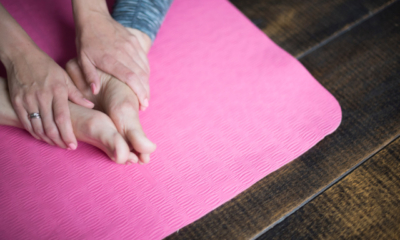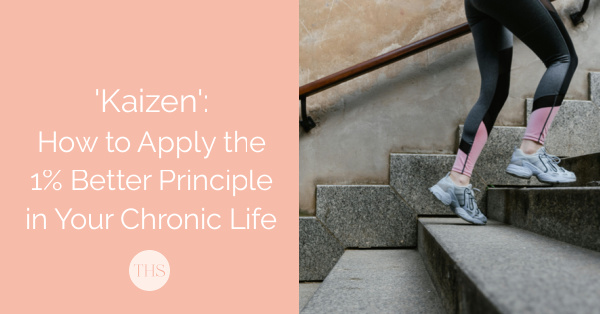How to Work on Your Recovery from Illness in Everyday Life

This article contains some affiliate links to products you may find useful, at no extra costs to you. All opinions are my own.
Does it ever feel like you’re hardly making any progress towards getting ‘better’? No matter if you’re working on your physical recovery, mental health or creating a good life for yourself with chronic illness, trying to improve yourself when living with epilepsy, arthritis or Crohn’s disease can feel like dancing the two-step – for every positive change you make, you’ll face some form of setback.
Because we’re so desperate to see results and find some relief from our problems, many of us are drawn to making big bold changes. You feel inspired to overhaul your lifestyle and eat clean, take up an exercise program and practice meditation every day, while doing the emotional work too.
And I totally get that – the idea of taking on such a project or challenge is very appealing, because it gives us hope that there is a magic cure. That if you work hard enough, you’ll find all that you’re looking for on the other side of that transformative experience.
And sometimes that’s true! But all too often, drastic changes do not lead to lasting results. Once the novelty wears off, your motivation drops, while shaking up all your daily routines at once requires a lot of brain power and energy. All too soon, everyday life – in the form of work deadlines, a bad night’s sleep, sick kids – starts getting in the way of sticking to your new habits.
Radical transformations just aren’t that sustainable in the long run, especially when you throw post-exertional malaise, flare-ups and other common health setbacks in the mix.
That’s where the concept of Kaizen comes to the rescue.

Kaizen is the Japanese term for ‘continuous development’. According to this business philosophy, making small, ongoing positive changes will lead to significant improvements.
The concept of Kaizen is somewhat similar to compound interest in economics. You see, when you make a one-time investment of money – let’s say $1000 – and you have an average interest rate of 7%, then after the first year, you’ll only have gained $70. But the next year, you won’t make 7% over $1000, but over $1070. In other words, you’ll earn interest over your interest, compounding your returns, which could eventually add up to nearly $2000 total in ten years time.
Well, Kaizen works the same for your habits, routines and wellbeing. Instead of trying to make a big change in a short time – and likely fail – you focus on making tiny improvements every day that will slowly but steadily build up to lasting change. It’s like a snowball: even if it doesn’t seem like you’re making much progress now, trying to get ‘1% better each day’ adds up in the long run.
By tackling a big goal this way, it becomes easier to pace your limited energy, avoid overwhelm, emotional burnout or worsening of your symptoms, and to create sustainable routines that you can keep doing, even on bad pain days.
“Success is the sum of small efforts, repeated day in and day out.” – Robert Collier
Ok, that sounds great, but how do you put the concept of Kaizen into practice, especially when you’re chronically ill?
The general idea is that you choose one small positive change that can have a big impact on your health and happiness.
Ask yourself, what are you struggling the most with right now, and which tiny action can you take to deal with the underlying cause of that problem? Don’t rush this step, because the most effective changes may surprise you.
For example, if you’d like to lose weight, maybe you shouldn’t start with a diet and workouts. Maybe getting more restful sleep will help you balance the hormones involved in hunger and feeling full, as well as effortlessly making better food choices because you’re well rested.
So what kind of tiny changes could you make to get 1% better each day? What works for you depends on your unique situation, but here are some ways to apply the concept of Kaizen to your chronic life:

As you can see, the options for 1% improvements are endless, and these small changes can be tailored to your health situation.

The caveat of Kaizen is that you do need to stick to your one small change long enough to notice results. Most of us tend to get impatient and quit before those tiny alterations can snowball into tangible outcomes.
What’s more, the 1% better principle only works if you keep making tiny improvements over time. There’s no need to rush, but once you can comfortable stick to your new routine but you haven’t reached your goal yet, don’t stop. Add one more minute of meditation to your sessions, do one extra squat, give another meal a healthy makeover.
One final tip: Making continuous improvement is not easy, so make sure you regularly fuel your motivation to keep going. Surround yourself with support and inspiring stories about overcoming adversity to remind yourself of the reason why you’re doing this, and why it will be worth the effort in the end.
Which one small change will you be making that could have a big impact on your wellbeing?
You can read more about getting 1% better in ‘One Small Step Can Change Your Life: The Kaizen Way’ by Robert Maurer and ‘Just One Thing’ by dr. Michael Mosley.
For more inspiration, also check out these 21 Simple Habits to Kickstart A Healthier Lifestyle, learn how exactly you can (re)build new habits, as well as how you can fuel your motivation to keep going when life is tough.